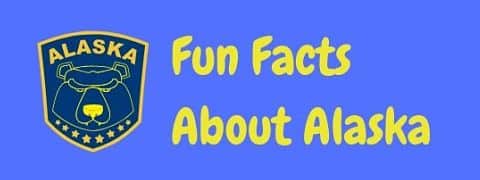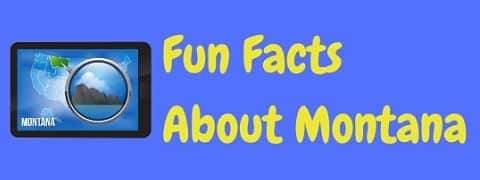Here is a fantastic collection of fun and interesting Alaska facts. Even those who are from the state may find things they didn’t know!
Alaska – the “Last Frontier” – is the biggest and most sparsely populated state in the U.S., and the most northwesternly landmass of the North American continent. The name derives from a word of one of the state’s many native peoples, the Aleut: Aleyska, which means “great land.” And “great” it is, host to some of the most stunning and impressive landscapes in the world, not to mention some truly glorious wildlife.
Here’s a rundown of some basic facts about this America’s amazing northland!

Alaska’s Geography Basics
The Last Frontier’s big, to put it mildly. Its land area of 586,412 square miles makes it by far the largest U.S. state, and about a fifth the size of the Lower 48. Counting islands, Alaska lays claim to nearly 34,000 miles of coastline: more than the seafront of all other U.S. states combined.
Thanks to the position of the International Date Line, the state technically contains not only the westernmost point in the U.S. – Amatiguak Island in the Aleutian archipelago – but also the easternmost, too: Semisopochnoi Island, also in the Aleutians and only about 70 miles away from Amatiguak.
Alaska’s border with Canada, at close to 1,600 miles long, accounts for more than one-third of the total U.S.-Canada border mileage. Meanwhile, a briny border of about 1,000 miles defines the frontier between Alaska and Russia. (In the Bering Strait, Alaska’s Little Diomede Island is only a little more than two miles east of Russia’s Big Diomede Island.)
Despite its massive geography extent, Alaska’s human population of roughly 700,000 is the 48th smallest of the 50 states, and it’s the least densely populated of them all, with only about one person per square mile. Most of that population calls Greater Anchorage and other parts of South-central Alaska home. Juneau, in Southeast Alaska, is the capital and the third-largest city (just a hair smaller than Fairbanks); it’s the only U.S. state capital not accessible by road.
Instead of counties, Alaska comes divided into boroughs: 20 of them, to be exact, one being the huge “Unorganized Borough.”
Mega Mountains
Alaska encompasses 17 of the 20 highest peaks in the U.S., including 20,320-foot Denali in the Alaska Range: the loftiest summit in North America. Denali also boasts the third-greatest topographic prominence – a measure of how high a peak rises above surrounding terrain – in the world, outdone only by Mount Everest and the high point of the Andes, Aconcagua.
The Saint Elias Mountains – which include Alaska’s second-highest peak, 18,008-foot Mount Saint Elias on the Yukon border – are the highest coastal mountains in the world and claim some of the most significant topographic relief.
Alaska, which falls within the so-called Pacific Ring of Fire, is home to more than 130 active volcanoes, and they include the highest in North America north of Mexico – 16,550-foot Mount Bona, in the Saint Elias Mountains – and also the world’s most symmetrical volcanic cone: 9,373-foot Mount Shishaldin, the high point of the Aleutians.
Alaskan Ice
Southern Alaska and adjacent parts of Canada claim the most glacial ice on the planet outside of Antarctica and Greenland. Ice fields cover some 29,000 square miles of the Last Frontier – about five percent of the state – and include some champion glaciers, including North America’s biggest, the Bering, and its longest tidewater glacier, the Hubbard, both of which fall within Wrangell-Saint Elias National Park & Preserve.
Rivers & Lakes
Alaska harbors some of the biggest and certainly the wildest rivers in America. The Yukon, which heads in Canada and crosses the Alaskan interior to the Bering Sea, is, at about 2,300 miles (1,875 of them in Alaska), the third-longest in the U.S. Its mouth forms one of the largest river deltas on the planet: the Yukon-Kuskokwim Delta. (The Yukon is the fifth-largest river draining the Arctic, after the Yenisei, the Lena, the Ob’, and the Mackenzie.)
Alaska includes better than three million lakes, the biggest of which by area is 1,150-square-mile Iliamna.
Weather Extremes
Alaska isn’t one big popsicle: There’s actually quite a lot of climatic variety, from the relatively mild (and very wet) temperate-rainforest realm of the southeast to the true Arctic climate of the far north. The subarctic continental climate of Interior Alaska is actually the most extreme: It’s seen both the hottest temperature (100 degrees Fahrenheit at Fort Yukon in June 1915) and the coldest (-80 degrees F at Prospect Creek in January 1971) recorded in the state.
Big Critters
Alaska’s varied and fairly pristine habitats give it an amazing roster of native wildlife. That includes some giant land mammals. Alaskan moose are the largest of their kind, and the Kodiak bear of southwestern Alaska’s Kodiak archipelago is the world’s heftiest subspecies of brown bear, with big males sometimes tipping the scales at more than 1,600 pounds.
The Kodiak bear vies with the polar bear, also native to Alaska, as the largest terrestrial carnivore in the world. Alaska is also home to some of the biggest gray wolves anywhere, and its wood bison – also found in northwestern Canada – is the heaviest of all bison.
Public Lands
About 2/3 of Alaska is federally managed public land. The state includes the largest national park in the U,S,: 20,587-square-mile Wrangell-Saint Elias National Park & Preserve. That park is also home to the single biggest federal wilderness area in the country, the approximately nine-million-acre Wrangell-Saint Elias Wilderness, but the adjacent Noatak and Gates of the Arctic wildernesses in Alaska’s Brooks Range create an even bigger swath of contiguous wilderness: close to 13 million acres.
Meanwhile, the Arctic National Wildlife Refuge on northeastern Alaska’s North Slope–which famously encompasses the calving ground of the Porcupine caribou herd–is, at almost 20 million acres, the nation’s biggest wildlife refuge.
Native Cultures & Languages
Alaska is home to numerous tribal entities within about 11 major cultural groups, and these peoples remain a vital and intrinsic part of the state’s identity. The state officially recognizes 20 native languages:
- Inupiaq
- Siberian Yupik
- Central Alaskan Yup’ik
- Alutiiq
- Unanga
- Dena’ina
- Deg Xinag
- Holikachuk
- Koukon
- Upper Kuskokwim
- Gwich’in
- Tanana
- Upper Tanana
- Tanacross
- Hän
- Ahtna
- Eyak
- Tlingit
- Haida
- Tsimshian
Statehood
Alaska was the 49th state to be admitted to the Union, achieving statehood on January 3, 1959. It was preceded by Arizona – made a state on February 1, 1912 – and followed just a few months later by Hawaii (August 21, 1959).
State Symbols
Alaska’s flag shows the “Big Dipper” asterism (an asterism is a part of a constellation) in Ursa Major, the “Great Bear,” and the North Star of Polaris. Its state marine mammal is the bowhead whale – a baleen whale that may live for more than two centuries – and its state land mammal is the moose. The state bird is the willow ptarmigan, the state insect the four-spot skimmer dragonfly, and the state fossil the woolly mammoth. The Sitka spruce – a sometimes-giant conifer native to southeastern Alaska’s rainforest – is the state tree, while the forget-me-not serves as state flower.
History Nugget: The Battle Of Attu
Attu Island in Alaska’s Aleutians was the site of the sole land battle of World War II found on U.S. soil, contested by Allied and Japanese forces in May 1943. Allied troops won the weeks-long Battle of Attu, which is today memorialized in a peace monument on the island.
Interesting Alaska Facts
If you found our fun Alaska facts interesting, why not check out all our other facts and trivia too, such as these:






